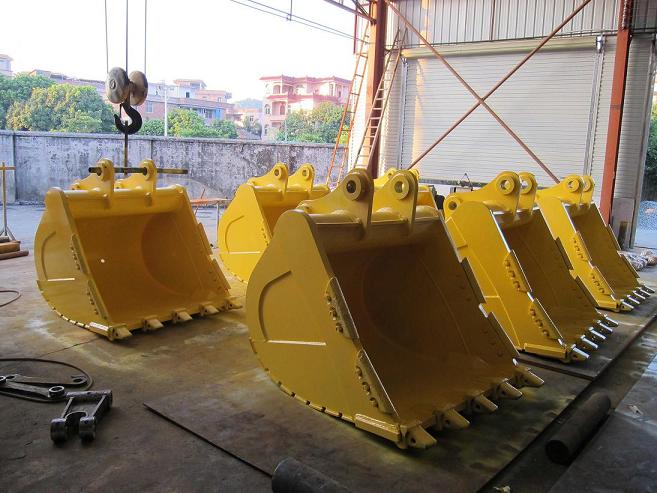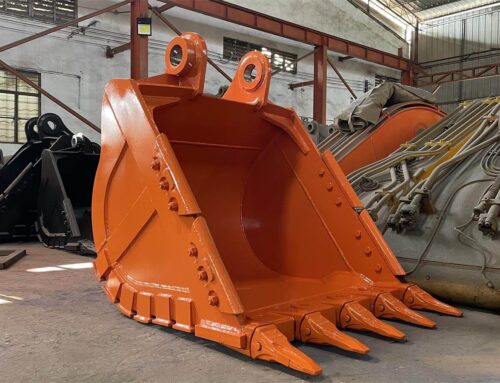In the world of heavy machinery, excavator bucket play a pivotal role in a wide range of construction and mining operations. These indispensable tools come in various sizes and configurations, each tailored to specific tasks and environments. Customizing excavator buckets is a strategic decision that demands careful consideration of numerous factors to ensure optimal performance, efficiency, and safety. This article delves into the critical data that needs to be confirmed when customizing excavator buckets, highlighting the importance of precision engineering in enhancing project outcomes.

Job Site Analysis
Before diving into the customization process, a comprehensive analysis of the job site and the intended application is essential. Factors such as soil type, material density, ground conditions, and space constraints all influence the design of the excavator bucket. By accurately assessing the requirements of the job, you can ensure that the customized bucket is tailor-made to tackle the challenges it will encounter.
- Soil Characteristics: Different soil types (such as clay, sand, gravel, and rock) have varying levels of hardness and abrasiveness. The bucket’s design, material choice, and cutting edge configuration should be aligned with the specific soil conditions to optimize digging performance and durability.
- Material Density: The density of the material being excavated impacts the bucket’s load capacity and wear resistance. Accurate data on material density ensures that the bucket is engineered to handle the intended workload without compromising efficiency.
- Working Depth and Reach: Confirming the required digging depth and reach ensures that the bucket is appropriately sized and designed to accommodate the excavation depth while maintaining stability and balance.
Excavator Bucket Design and Configuration
Once the job site analysis is complete, the next step involves determining the bucket design and configuration that best suits the application. This involves fine-tuning various aspects of the bucket’s construction.
- Bucket Type: Choose between different bucket types such as general purpose, trenching, rock, or grading buckets based on the specific task requirements. Each type has unique features optimized for distinct applications.
- Capacity and Volume: Calculate the desired bucket capacity and volume to ensure efficient material handling. A well-sized bucket prevents overloading the excavator and maintains optimum productivity.
- Cutting Edge and Tooth Configuration: The shape and arrangement of the cutting edge and teeth significantly impact digging efficiency and wear resistance. Proper tooth selection enhances digging performance and minimizes maintenance.
Material Selection
Selecting the appropriate material for the excavator bucket is a crucial step in the customization process. The chosen material should offer an optimal balance between strength, durability, and weight.
- Material Strength: The bucket’s material should have the required tensile and yield strength to withstand the forces exerted during excavation. Higher-strength materials are essential for handling tougher applications.
- Wear Resistance: Considering the abrasive nature of excavation tasks, the bucket material must exhibit excellent wear resistance to prolong its lifespan and reduce downtime for maintenance.
- Weight Optimization: Balancing material strength with weight is crucial for the excavator’s overall stability and fuel efficiency. Opting for lighter yet robust materials contributes to better machine performance.
Attachment Compatibility
The customized excavator bucket should seamlessly integrate with the excavator’s attachment system, ensuring secure attachment and ease of use.
- Attachment Interface: Confirm compatibility with the excavator’s quick coupler system or other attachment interfaces to enable quick and safe bucket changes.
- Hydraulic Requirements: Ensure that the bucket’s hydraulic connections align with the excavator’s hydraulic system, allowing smooth operation and optimal control.
- Safety and Operator Comfort
The safety of operators and those working in the vicinity of the excavator is of paramount importance. Customized bucket designs should prioritize operator visibility, ergonomics, and safety features.
- Visibility: The bucket design should provide optimal visibility to the operator, allowing precise maneuvering and preventing accidents.
- Operator Comfort: Ergonomically designed buckets with well-positioned controls and reduced vibration contribute to operator comfort and productivity during long working hours.
- Safety Features: Incorporate safety enhancements such as bucket teeth retention systems, spill guards, and reinforcement to protect against material spillage and equipment damage.
Environmental Considerations
In today’s environmentally conscious landscape, considering the ecological impact of equipment and operations is crucial.
- Environmental Regulations: Ensure that the customized bucket adheres to local environmental regulations and emissions standards.
- Sustainability: Opt for materials and manufacturing processes that minimize environmental impact, such as using recyclable materials and reducing energy consumption.
Conclusion
Customizing excavator buckets is a precise and intricate process that demands careful consideration of various data points. By thoroughly analyzing the job site, selecting the appropriate design and materials, ensuring compatibility, prioritizing safety and operator comfort, and addressing environmental concerns, a customized excavator bucket can be engineered to optimize performance and efficiency while contributing to a safer and more sustainable working environment. In this realm of heavy machinery, attention to detail truly makes the difference between an ordinary excavation and a remarkably successful project.
Maintenance and Longevity
A well-designed customized excavator bucket should not only excel in performance but also exhibit extended longevity with minimal maintenance requirements.
- Maintenance Considerations: Integrate design features that facilitate ease of maintenance, such as accessible grease points, replaceable wear parts, and simplified disassembly for repairs.
- Wear Protection: Utilize wear-resistant materials and protective coatings in high-wear areas of the bucket to enhance its durability and reduce the frequency of replacement.
- Lubrication: Confirm that the bucket’s pivot points and moving components are adequately lubricated to prevent premature wear and ensure smooth operation.
Excavator Bucket Performance Validation and Testing
Before deploying the customized excavator bucket in a real-world application, it is crucial to validate its performance through rigorous testing.
- Prototype Testing: Build and test a prototype of the customized bucket to assess its functionality, durability, and overall performance under simulated job site conditions.
- Performance Metrics: Establish benchmarks for key performance metrics such as digging efficiency, load capacity, and wear resistance. Compare the bucket’s actual performance against these metrics during testing.
- Iterative Refinement: Based on testing results, iterate on the bucket design to address any identified shortcomings and further optimize its performance.
Collaboration and Communication
The customization process involves close collaboration and communication among various stakeholders, including equipment manufacturers, engineers, operators, and project managers.
- Operator Feedback: Engage operators who will be using the customized bucket to gather their insights and preferences, ensuring that the final design aligns with their operational needs.
- Clear Specifications: Provide clear and detailed specifications to manufacturers and engineers to ensure accurate implementation of the desired customization.
- Timelines and Expectations: Establish realistic timelines for the customization process and communicate expectations regarding project milestones and delivery.
Conclusion
Customizing excavator bucket is a meticulous endeavor that demands a thorough understanding of the job site, materials, design principles, operator needs, and environmental considerations. By meticulously confirming critical data points throughout the customization process, construction and mining professionals can achieve excavator buckets that not only meet but exceed project requirements. These custom solutions not only enhance efficiency and productivity but also contribute to safer operations, reduced downtime, and a more sustainable approach to heavy machinery use.
In the realm of heavy equipment customization, the pursuit of precision extends beyond engineering calculations; it encompasses a holistic approach that considers all facets of the equipment’s performance, safety, and impact on both the job site and the environment. By acknowledging and confirming the essential data points outlined in this article, you pave the way for the successful implementation of a customized excavator bucket that sets new standards for excellence in construction and mining operations.






Leave A Comment